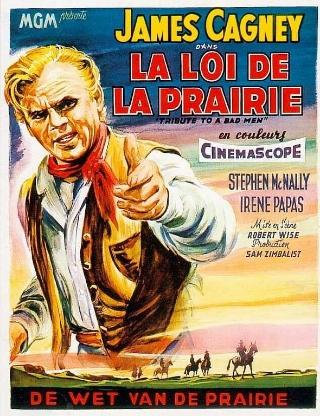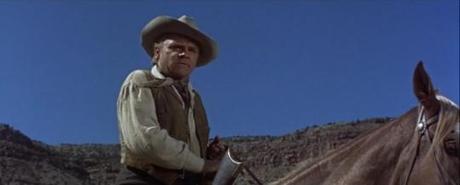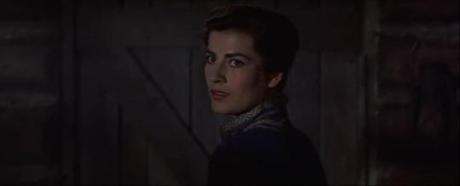
We’re living in the middle of nowhere. Two hundred miles from any kind of law and order. Except for what I built myself. Ever since I started – and this you don’t know – I’ve been badgered, skunked, bitten out and bushwhacked by thieves from everywhere. And now, one of my men’s been killed. I find my horses, I find the killer. If I find the killer, I hang him.
Sometimes little gems pass us by, having escaped our attention for one reason or another. Discovering such films is a genuine pleasure, a reminder that there are always cinematic nuggets to chance upon. Tribute to a Bad Man (1956) is a case in point, a movie I was aware of but had never seen. I’ll readily admit here that this may have been at least partially due to a certain prejudice on my part; neither the stars nor the director are people one automatically associates with the western. I guess my enjoyment of Robert Wise’s two earlier genre efforts, coupled with the recommendations of others, drew me to the film. The presence of James Cagney (who made only three westerns himself) and Irene Papas had me feeling less confident. However, I was delighted to find that any reservations were entirely misplaced – if anything, Tribute to a Bad Man proves how the genre has a tendency to bring the best out of talented performers and filmmakers.
The plot recounts a short episode in the life of a young man, a parable of renewal in the best tradition. Steve Miller (Don Dubbins) is a green easterner, a store clerk from Pennsylvania heading west to carve out a new life. Riding into a lush valley, he stumbles into an ambush in progress. A wounded man is pinned down with only the carcass of his slain horse for cover. Miller’s unexpected appearance on the scene drives off the bushwhackers and earns him the gratitude of the man he’s saved. This is Jeremy Rodock (James Cagney), a prosperous horse rancher and owner of the valley. Miller’s reward is to be taken on as a wrangler, but it also draws him into the harsh and complex world of Rodock. And it is completely his world; Rodock’s wealth and hard-bitten personality have made him the total master of his domain. In a land as yet untouched by the civilizing influence of the law, his authority is absolute and he quite literally holds the power of life and death when any crime takes place. The west at this time was very much a man’s country, with women thin on the ground. Rodock is one of those classic western types who has lived much of his life alone, but there is a woman in his home now. Jocasta Constantine (Irene Papas) is a Greek immigrant he has taken from the Cheyenne saloon where he found her and brought back to his ranch. It’s at this point that the film comes into its own, raising all kinds of questions about trust, suspicion and the way it’s all too easy to hide from and deny one’s true feelings. Rodock has relied on himself and his own instincts for so long that he’s slow to trust. He’s become a hard man, masking a deep insecurity with an uncompromising exterior. There’s a kind of messianic zeal about the way he metes out his brand of justice, hanging any horse thieves who dare raid his stock. But his suspicion of potential criminals extends into his personal life too – he’s consumed with doubt when it comes to Jocasta, fearing the attractions of his head wrangler McNulty (Stephen McNally) and later Miller will be more than she can resist.

Tribute to a Bad Man was adapted from a story by Jack Schaefer, and I’ve yet to see a film derived from his work that’s left me dissatisfied. There’s a timeless quality which I feel comes from the focus on interesting characters and deeply affecting relationships. This isn’t a shoot-em-up western, rather it’s a character study which draws you in gradually. That’s not to say there are no action scenes – there are, but they certainly take second place. Mostly the movie concerns itself with Rodock and his relationship with Jocasta. Even the name Jocasta is highly suggestive, with its allusions to Greek mythology – Jocasta was the mother of Oedipus, who of course unwittingly killed his father and proceeded to marry his mother. I think it’s therefore intended that we see Rodock as a kind of Laius figure, simultaneously in love with Jocasta, deeply suspicious of what it may lead to, and also forever aware of the threat to him posed by younger men. Nevertheless, while an awareness of this aspect can add another layer of appreciation, it’s not an essential reading of the plot. What really matters here is the way an essentially decent man has allowed himself to succumb to cruelty, and how he rediscovers and regains his humanity. In this version Jocasta isn’t the tragic figure but instead represents salvation for Rodock.
I think it’s a pity Robert Wise didn’t make more westerns. All three of his genre efforts are fine movies, although I probably enjoyed Tribute to a Bad Man most. Aside from the rich, classical theme, the movie simply looks great throughout. Filming in CinemaScope, Wise and cameraman Robert Surtees use the wide frame to full effect, and the Colorado locations appear quite spectacular. Furthermore, the interiors are well used too. Wise and Surtees achieve good depth and contrast in those scenes – the grimy, smoky bunkhouse looking particularly authentic. The director’s judgment of the pacing was spot on too, letting scenes play out naturally but never allowing them to overstay their welcome. A polished and professional piece of work all round.

As I said at the beginning, James Cagney simply isn’t someone typically associated with the western – his fast-talking persona seemed to belong to a different period and location. And yet I never once found myself thinking there was anything anachronistic or out of place about his presence in Tribute to a Bad Man – which is a tribute itself to the talent and versatility of the man. Cagney of course wasn’t the first choice for the role of Rodock; Spencer Tracy was initially cast but his reluctance to spend so much time on location led to his leaving MGM and being replaced by Cagney. The character of Rodock wasn’t an easy one to play – he’s not really the bad man the title suggests, at least not in the formal sense of the word. On their own, the prickliness, uprightness and bursts of cruelty could probably be handled fine by a number of actors. Cagney’s skill though lay in his ability to ensure Rodock never became wholly unlikable at any point; the fundamental honor and decency of the man were never far from the surface and that Irish twinkle would flash in his eyes at just the right moment. Irene Papas is another performer you don’t expect to see in a western – she hasn’t even made that many English language films all told. Once again though we can see this genre encouraging fine performances from people who, on paper anyway, sound like odd choices. Papas was one of only two women in the cast, and her striking Greek features make her stand out even more. This was her Hollywood debut and she carried off the role of Jocasta with style. Her character was at the heart of the story, the one who brings Rodock back to full life, and any weakness would have derailed the whole thing. She got across the right combination of sassiness, allure and soulfulness to make it all entirely believable, and even the significant age difference with Cagney is used to the film’s advantage.
Stephen McNally could play heroes, villains and everything in between with ease. Here he was the villain, a slick opportunist willing to gamble on anything and lacking any real moral sense. Probably his finest moment in the movie comes when he has to endure the sadistic punishment Rodock devises to pay him back for crippling his horses – grueling stuff and well handled by McNally. Don Dubbins was fine as the everyman narrator, ultimately it’s something of a thankless part but he did all that was asked of him. The supporting cast all have smaller roles but Vic Morrow got handed a reasonably meaty part as the embittered son of Cagney’s former partner. The other parts are filled by such familiar faces as Lee Van Cleef. Royal Dano, Jeanette Nolan, Chubby Johnson and James Griffith.
Tribute to a Bad Man is available from a number of sources on DVD now. There’s a Warner Archive MOD disc out in the US, a Spanish release – which I think is non-anamorphic letterbox – and this Italian edition from A & R Productions which I own. I have a few titles by this company now and I’ve been very satisfied with them so far. The movie is presented in its correct scope ratio and anamorphically enhanced. The print used is crisp, clear and colorful with no significant damage. The film can be viewed either with its original English soundtrack or an Italian dub, and there are no subtitles at all offered. Extras consist of the theatrical trailer and a selection of galleries. All in all, I really enjoyed this film. It’s a first-rate western in my opinion, and ought to have more fans. I can certainly see myself revisiting it and I recommend anyone who hasn’t seen it check it out.
